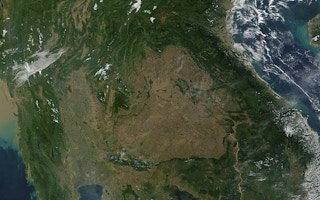Despite ongoing deforestation, fires, drought-induced die-offs, and insect outbreaks, the world’s tree cover actually increased by 2.24 million square kilometers — an area the size of Texas and Alaska combined — over the past 35 years, finds a paper published in the journal Nature. But the research also confirms large-scale loss of the planet’s most biodiverse ecosystems, especially tropical forests.
The study, led by Xiao-Peng Song and Matthew Hansen of the University of Maryland, is based on analysis of satellite data from 1982 to 2016. The researchers broke land cover into three categories: tall vegetation consisting of trees of at least five meters (16 feet) in height; short vegetation under five meters in height including shrubs, grass, and agricultural crops; and “bare ground”, including urban areas, sand, tundra, and rock. While the classification may seem simplistic, powerful conclusions can be drawn from the data, including assessing agricultural expansion, climate-driven expansion and contraction of ecosystems, and forest clearing and recovery.
“The results of this study reflect a human-dominated Earth system,” the researchers write. “Direct human action on landscapes is found over large areas on every continent, from intensification and extensification of agriculture to increases in forestry and urban land uses, with implications for the maintenance of ecosystem services.”
Overall, the study found that tree cover loss in the tropics was outweighed by tree cover gain in subtropical, temperate, boreal, and polar regions. Tree cover gain is being driven by agricultural abandonment in parts of Europe, Asia, and North America; warming temperatures that are enabling forests to move poleward; and China’s massive-tree planting program. Tree cover is also increasing globally in montane areas.
“
A global net gain in tree canopy contradicts current understanding of long-term forest area change.
The biggest gains in tree cover occurred in temperate continental forest (+726,000 square kilometers), boreal coniferous forest (+463,000 square kilometers), subtropical humid forest (+280,000 square kilometers). Russia (+790,000 square kilometers), Colombia (+324,000 square kilometers) — perhaps due to forest regrowth during the decades-long conflict with the FARC, and the United States (+301,000 square kilometers) experienced the largest increase in tree cover among countries during the period.
By contrast, the tropics saw substantial losses in tree cover, led by tropical moist deciduous forest (-373,000 square kilometers), tropical rainforest (-332,000 square kilometers), and tropical dry forest (-184,000 square kilometers). Tropical dry forest had the highest rate of loss over the 35 years at 15 per cent. Brazil led the world by far in tree cover loss, losing 399,000 kilometers, more than the combined total loss of the next four countries on the list (Central African Republic, Russia, Argentina, and Paraguay).
The study estimates gross tree canopy loss globally at 1.33 million square kilometers, or 4.2 per cent of 1982 tree cover. But adding in gains, the planet’s total area of tree cover increased by 2.24 million square kilometers, or 7.1 per cent, from 31 million to 33 million square kilometers. The authors note these numbers “contradict” data from the United Nations Food and Agriculture Organization (FAO), which collects national forest data from countries’ forestry departments and has historically been seen as the most consistent source of informations on forest cover.
“A global net gain in tree canopy contradicts current understanding of long-term forest area change; the Food and Agriculture Organization of the United Nations (FAO) reported a net forest loss between 1990 and 2015. However, our gross tree canopy loss estimate (−1.33 million square kilometers, −4.2 per cent) agrees in magnitude with the FAO’s estimate of net forest area change (−1.29 million square kilometers, −3 per cent), despite differences in the time period covered and definition of forest.”
However all the tree cover data comes with an important caveat: tree cover is not necessarily forest cover. Industrial timber plantations, mature oil palm estates, and other non-natural “planted forests” quality as tree cover. For example, cutting down a 100-hectare tract of primary forest and replacing it with a 100-hectare palm plantation will show up in the data as no net change in forest cover: the 100-hectare loss is perfectly offset by the 100-hectare gain in tree cover. Yet, that activity would be counted as “deforestation” by FAO. Therefore tree cover loss does not directly translate to “deforestation” in all cases.
Nonetheless, establishing a record of change in land cover will enable researchers to eventually distinguish between different types of activities. And the data in the current study does offer insights when there is a change between vegetation types.
“Deforestation for agricultural expansion is often manifested as tree canopy loss and short vegetation gain, whereas land degradation may simultaneously result in short vegetation loss and bare ground gain,” write the researchers, who used sampling to create model that enabled them to attribute land use change to direct human activities or indirect drivers like climate. The study concludes that 60 per cent of all change during the study period were associated with human activities. Attribution varied across biomes, with direct human impact associated for 70 per cent of tree canopy loss (e.g. deforestation), but only 36 per cent of bare ground gain (e.g. tundra being colonized by poleward migrating vegetation as temperatures climb).
This story was published with permission from Mongabay.com. Read the full story.










